We are pleased to announce that a successful collaboration between glyXera and the Department of Biosciences at the University of Salzburg and the Christian Doppler Laboratory for Innovative Tools for Biosimilar Characterization at the University of Salzburg led to another peer reviewed open access research paper in mAbs (published by Taylor & Francis), titled “Unambiguous identification of α-Gal epitopes in intact monoclonal antibodies by NMR spectroscopy”.
A terminal α-Gal epitope (sometimes also called Galili epitope) on the glyco-moiety of proteins can cause severe immune reactions in humans and thus is classified as a critical quality attribute of biopharmaceuticals. Recombinant therapeutic proteins expressed in murine cell lines such as NS0 or SP2/0 typically contain α-Gal epitopes (as well as some CHO cells, under certain conditions) and therefore their absence or presence needs to be tightly monitored to minimize any undesired adverse effects. The analytical identification of α-Gal epitopes in glycoproteins is challenging with the common standard techniques based on LC-MS, mainly due to isobaricity of hexose stereoisomers.
Thus, orthogonal glycoanalytical methods are desirable for cross-validation of the possible presence of α-Gal e.g. in mAbs. As a proof of concept, a variety glycoanalytical methods – namely, NMR, LC-MS, CE-MS, and our proprietary xCGE-LIF-based glycan analysis platform technology – were employed to analyze different mAbs. While rituximab, adalimumab, denosumab and trastuzumab did not show the α-Gal epitope, in cetuximab significant amounts (up to 36.3%) were found.
The article is published open access and can be read in full on the publication web page: https://www.tandfonline.com/doi/full/10.1080/19420862.2022.2132977
If you would like to learn more about our range of xCGE-LIF-based glycoanalytical products, including glyXboxCE, glyXprep, and glyXtoolCE, and about their many possible applications, please feel free to get in touch.

